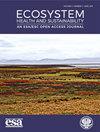How urbanization affect the ecosystem health of Tibet based on terrain gradients: a case study of Shannan, China
IF 3.4
2区 环境科学与生态学
Q1 ECOLOGY
引用次数: 4
Abstract
ABSTRACT Urbanization has significant impacts on ecosystem health (ESH) by affecting land-use patterns. The evaluation of the ESH and the spatial correlations between human interference provides an insight into sustainable development as a response to potential ecological degradation if ESH is threatened by further urbanization. We applied the Vigor-Organization-Resilience-Services (VORS) modelto detect the responses of ESH of Shannan Prefecture in the Tibet to urbanization from 1990 to 2015, based on different levels of terrain gradients. The results show that the ESH of the most areas in Shannan reaches the levels of highest health and average health during the study period. By 2015, the area proportion at the highest health level increased by 0.68%, while that of degraded level decreased by 1.51%. Overall, the ESH of areas tends to shrink at higher-level TGs, and urban sprawl with ESH shrinking existed in middle-level TGs in Shannan. Furthermore, a significant spatial aggregation effect was found concerning that low ESH–high CUL type is mainly distributed on the middle-level TGs with dense human population. The results highlight the needs to rationally organize urbanization process in plateau regions based on different TGs, which contribute to maintain ESH advancing people livelihood improvement.基于地形梯度的城市化对西藏生态系统健康的影响——以山南为例
城市化通过影响土地利用模式对生态系统健康产生显著影响。对生态环境的评价和人类干预之间的空间相关性提供了一个深入了解可持续发展作为对潜在生态退化的响应,如果生态环境受到进一步城市化的威胁。基于不同地形梯度,应用活力-组织-弹性-服务(VORS)模型对1990 - 2015年西藏山南地区ESH对城市化的响应进行了研究。结果表明:研究期间,山南大部分地区的ESH均达到最高健康水平和平均健康水平。到2015年,最高健康水平的面积比例增加了0.68%,退化水平的面积比例下降了1.51%。总体而言,山南地区高水平地级市的城市用地面积有收缩的趋势,中等水平地级市存在用地面积收缩的城市蔓延。低esh -高CUL型主要分布在人口密集的中级地区,具有显著的空间聚集效应。研究结果表明,高原地区应根据不同的城镇化目标,合理组织城市化进程,以维持生态环境,促进人民生活水平的提高。
本文章由计算机程序翻译,如有差异,请以英文原文为准。
求助全文
约1分钟内获得全文
求助全文
来源期刊

Ecosystem Health and Sustainability
Environmental Science-Management, Monitoring, Policy and Law
CiteScore
7.10
自引率
2.00%
发文量
40
审稿时长
22 weeks
期刊介绍:
Ecosystem Health and Sustainability publishes articles on advances in ecology and sustainability science, how global environmental change affects ecosystem health, how changes in human activities affect ecosystem conditions, and system-based approaches for applying ecological science in decision-making to promote sustainable development. Papers focus on applying ecological theory, principles, and concepts to support sustainable development, especially in regions undergoing rapid environmental change. Papers on multi-scale, integrative, and interdisciplinary studies, and on international collaborations between scientists from industrialized and industrializing countries are especially welcome.
Suitable topics for EHS include:
• Global, regional and local studies of international significance
• Impact of global or regional environmental change on natural ecosystems
• Interdisciplinary research involving integration of natural, social, and behavioral sciences
• Science and policy that promote the use of ecological sciences in decision making
• Novel or multidisciplinary approaches for solving complex ecological problems
• Multi-scale and long-term observations of ecosystem evolution
• Development of novel systems approaches or modeling and simulation techniques
• Rapid responses to emerging ecological issues.
 求助内容:
求助内容: 应助结果提醒方式:
应助结果提醒方式:


